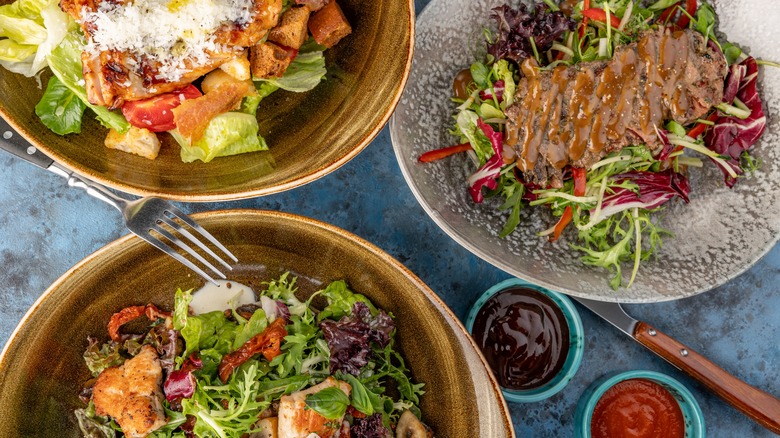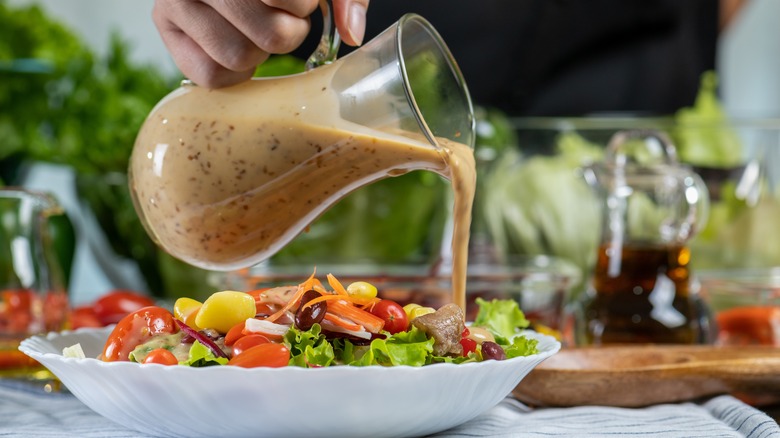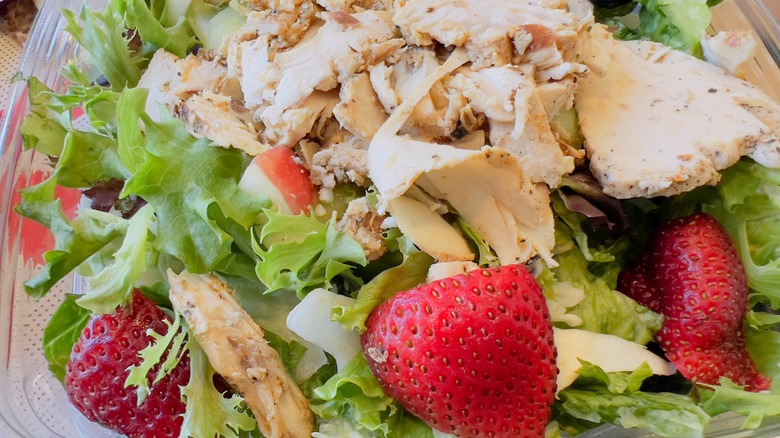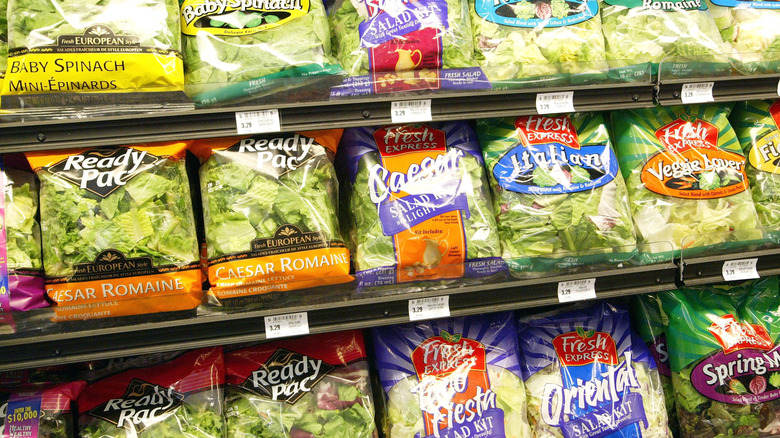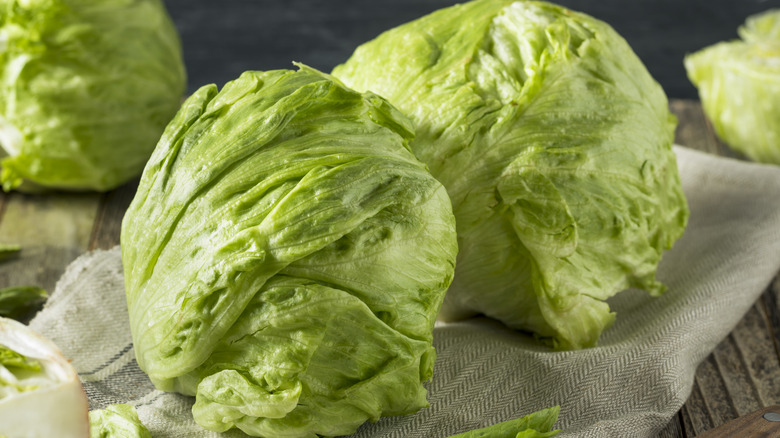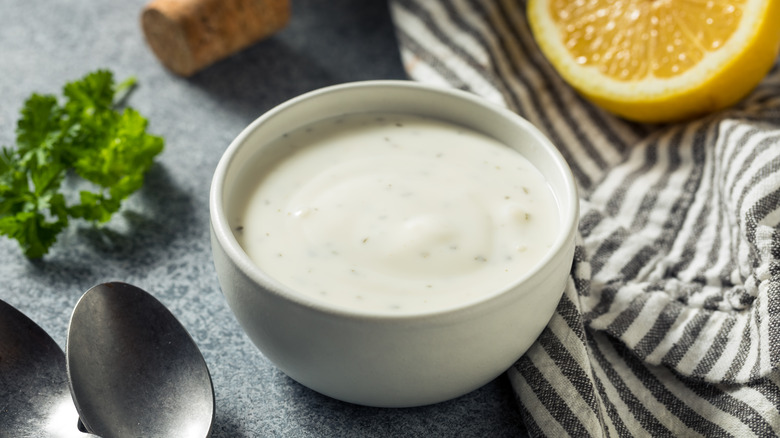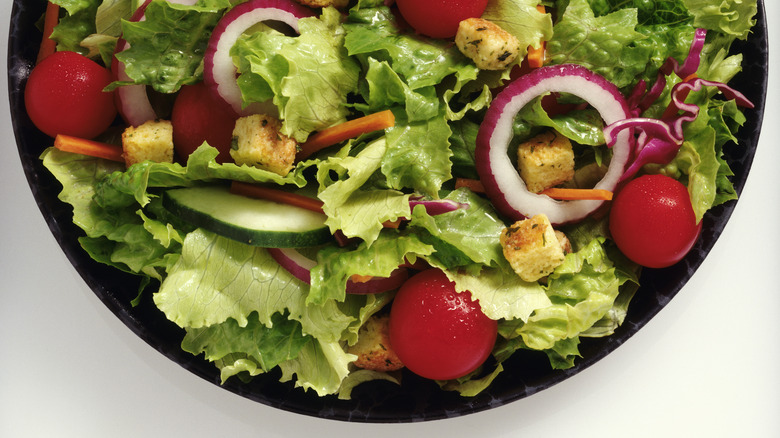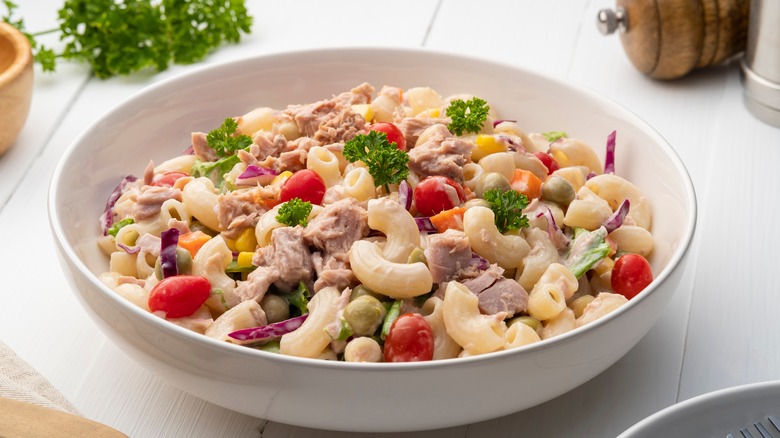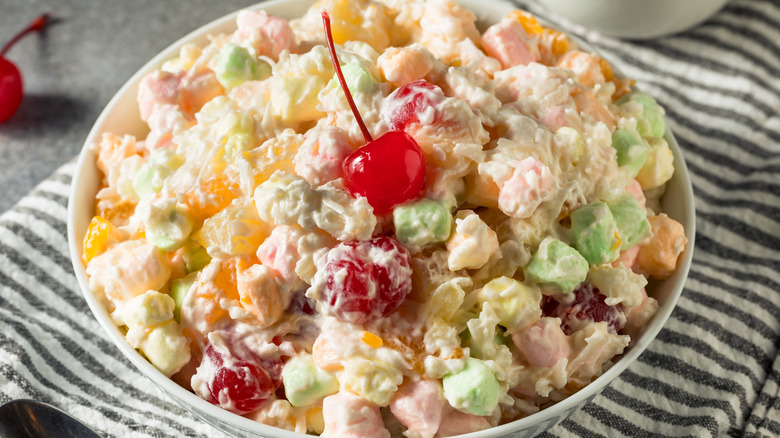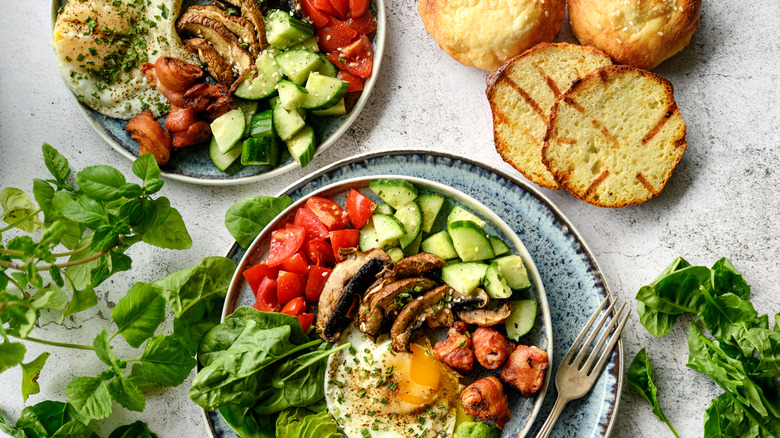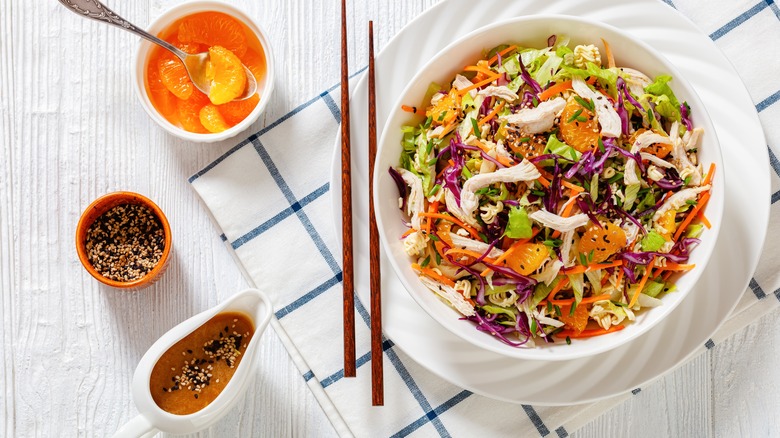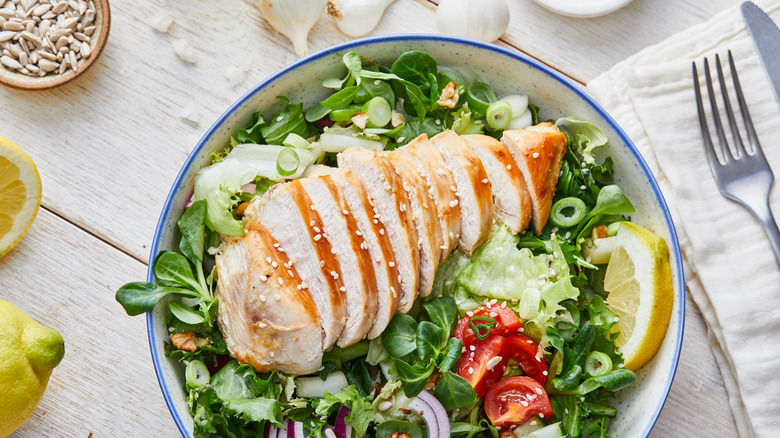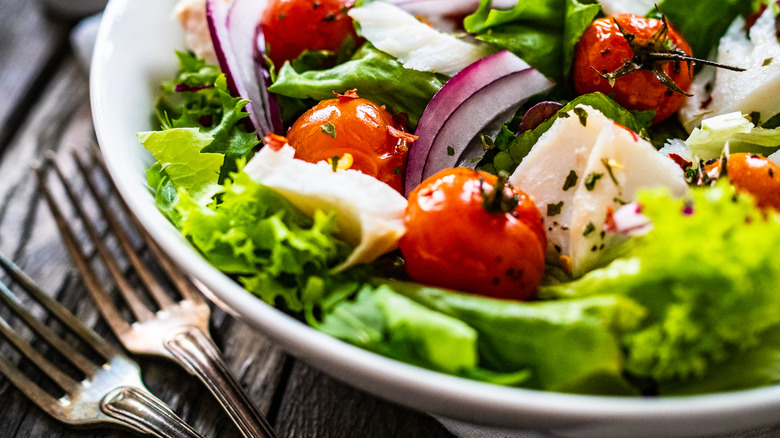False Facts About Salad You Thought Were True
According to research, the average person in the US has at least four salads weekly. Even if those who participated in this study were telling a fib to the surveyors (and themselves) to make their lifestyles seem a lot more healthy, the fact is, salad is a dish that's always on our mind. But for a food that's been around for centuries and is served at as many dine-in as fast food restaurants, salad is a mysterious and slippery mistress. There are as many rumors and claims about salad floating around the internet and out of the general public's mouths as there are salad types.
A fruit salad is actually not a salad, some cry. Bagged salad will literally kill you, say others. Iceberg lettuce is not even healthy and should never be used as a salad base, cry a strangely angry few. But today foodies, we are going to put the rumors about salad to rest. We have compiled a list of the top salad myths you may be falling for to help you differentiate fact from fiction and finally shed some light on one of history's most recognized food icons.
False Fact: A salad is always the healthiest choice
We all know the food law basics: chocolate is bad for you and salad is good for you ... right? Well, even though we associate this vegetable-laden dish with the iconic health halo of ole, a salad being a salad, doesn't make it the best better-for-you choice on the menu. Certain salads can be downright bad for your health. But what differentiates a healthy dish of lettuce and veg from a false green god? It all comes down to a salad's ingredients.
Brace yourself for disappointment because the fixings that make salad unhealthy are typically delicious. One such popular offender is bacon bits, which typically clock in at 30 calories a tablespoon and offer a lot of sodium for very little nutritional value. While salad dressing can turn your sad salad into a flavor party, many of salad-loving society's favorite kinds of dressing are high in calories and fat — with most ranch dressings packing 130 calories and 13 grams of fat per 2-tablespoon serving.
Such high-cal, high-fat add-ins are the reason why Chick-fil-A's 5-count of fried chicken nuggets are healthier than its Cobb Salad. The salad, which includes fried chicken, bacon bits, and avocado lime dressing, comes in at 830 calories and 60 grams of fat. In contrast, the nuggets offer a mere 160 calories and only 7 grams of fat. So foodies, if you're trying to eat healthier, whether it's a salad or not, always check your food's nutritional facts.
False: Fast food salads are bad for you
In perhaps an interesting display of the duality of man, although many people associate "salad' with "health," just as many health-conscious foodies tend to automatically identify "fast food salad" with "terrible, terrible slush that will kill you with its preservatives." But hold on there cowboy, that also is simply not the case. While yes, some fast food salads (like the aforementioned Chick-fil-A Cobb Salad abomination) are pretty bad for your health, some quick-service chains actually offer good-for-you salads on the cheap.
For example, Panera Bread's Asian Sesame Salad with Chicken comes in at only 410 calories a serving while offering 29 grams of protein. In an act of redemption, Chick-fil-A's Market Salad is loaded with fresh fruits like strawberries and apples, and offers a reasonable 550 calories and 28 grams of protein per fruit and green-filled bowl. According to dietitians, the plan of action you need to take to ensure your fast food salad beau is nutritious is the same plan of action you need to take to ensure a salad you make at home or order at a sit-down restaurant is good for you — check those ingredients and nutrition facts.
False: Pre-made grocery store salads are the enemy
Now, we're jumping from fast food slander and straight into the "Anything that comes prepackaged is bad for you" mantra the green juice-loving health influencers of the interwebs often shout on social media, because bagged salad has been personally victimized by this incorrect information. Due to such cruel rhetoric, many people have come to believe that not only are bagged salads less nutritionally dense than ones you'd DIY yourself, but that packaged greens come teeming with nasty little bacteria that will give you Listeria monocytogenes. Luckily for all the busy people on the go, several health professionals have gone on record to clear bagged salad's name.
Per nutritionists, food safety institution employees, and pretty much anyone who knows their way around a nutrition label, bagged salads have about as much nutritional value as your average lettuce head in the grocery store. Even though our prepackaged pal's ingredients' nutritional value drops when they are being prepped for packing because a bagged salad is ... bagged, its ingredients' nutrition holds up since they are protected by their pretty much vacuum-sealed plastic covering. Meaning, that the end result's nutrition is equivalent to a lettuce head that's just been washed and left in the veggie aisle. As for the bacteria — yes, it's true that bagged salad can have squiggly wiggly diseases in it, but you're as likely to bite into a diseased cabbage head as you are to buy a bacteria-ridden bagged salad.
False: Iceberg lettuce is not worth your salad's space
Stop us if you've heard this one before — iceberg lettuce, that crunchy delicious green that's the most beloved salad base in the U.S., is useless, water-filled, and nutrition-less. We are here to tell you these are slanderous lies. While iceberg lettuce is composed of 96% water, it also offers its adamant eaters vitamin K (which wards off blood clots), vitamin A (which helps keep your eyes in tip-top functioning order), and folate (a nutrient known for aiding our bodies in producing that oh-so-important DNA). Plus, all that water, as some dietitians have pointed out, isn't a bad thing. Statistically speaking, we as humans typically don't drink enough of it — in fact, 47% of us don't hydrate properly (via CivicScience). We all need some iceberg lettuce (and a water bottle) in our lives.
Of course, spinach and kale do provide salad munchers with a lot more nutritional value than iceberg lettuce — with kale containing antioxidants and other such health boosters as vitamin C, and spinach offering all the aforementioned vitamins and a dose of potassium. But because iceberg lettuce has its own unique attributes, instead of ditching it altogether, most dietitians recommend including all three leafy greens in your salad bowl to make the best healthy meal possible.
False: Low-fat salad dressing is the way to go
When reaching for salad dressing, your hand better not grab a bottle of the low-fat stuff. Yes, low-fat salad dressing has a lot fewer calories than its full-fat counterpart (as we noted before, an average 2 tablespoon serving of ranch dressing usually has around 130 calories, whereas the same amount of a low-fat version comes in at a mere 15 calories), but calories aren't everything. In many ways, low-fat salad dressing is worse for your health than the full-fat stuff.
According to research from Purdue University, the oh-so-pesky fat in dressing is actually what helps our bodies take in a salad's carotenoids. These funky-sounding nutrients are known to help ward off some of the big daddies of bad ailments: cancer and heart disease. So, if you're trying to keep your meal on the lighter calorie side, experts recommend ditching the low-fat stuff and using a reasonable portion of oil dressings. The studies show that even if you use a smaller amount of these dressings (and, by extension, put a smaller amount of fat on your salad), you will still help you absorb your salad's nutrients.
False: A traditional garden salad only has carrots, cucumbers, and tomatoes
While the health-conscious and semi-conscious all get excited at the prospect of a cobb or market salad (delicious chicken and fruit, oh boy!), most treat eating garden salad like a task that must be begrudgingly completed for the sake of their health. After all, this veggie-laden dish contains nothing but carrots, tomatoes, cucumbers, and maybe some cheese — so, really, what is there to be excited about? But here's the deal — restaurants have been pulling the complimentary salad wool over your hungry eyes for years. Garden salads can be so much more than three types of "eh" tasting vegetables and some leaves. It's the vegetables, in fact, that make garden salads good.
Forget only using tomato and celery, you can throw any vegetable you want into the green garden mix. Salad eaters who know what they are doing have thrown everything from earthy mushrooms and peas to crunchy, munchy bell peppers into their garden salads. Heck, people have even added some kick to this traditional dish by tossing chili peppers into their greens. So, instead of hating on garden salads and what they can do for your taste buds, you should start asking garden salads what you can do (and what vegetables you can add) to make them properly delicious.
False: Salads always start with greens
Tell us, food lovers, what is salad? We're not being cute here, this is a real question. For most people, the first image that pops into mind when hearing the word "salad" is a dish featuring vegetables on top of a bed of greens. In fact, one poll by Fresh Express surveyed 2,000 salad-adoring Americans and revealed that 31% of the U.S.'s salad-eaters prefer iceberg lettuce as their salad base of choice, and 25% love kale. Some salad fans may even go far as to say pasta salad, in all its non-leafy-green glory, is not a real salad. But au contraire food friends, per Merriam-Webster's definition of a salad is, and we quote, "small pieces of food (such as pasta, meat, fruit, or vegetables) usually mixed with a dressing (such as mayonnaise) or set in gelatin."
So, then pasta as a salad is completely right in claiming their salad identity — plus they've been around almost as long as vegetable salads, as they were first assembled and enjoyed hundreds of years ago by Jewish Italians, so respect your salad elders. However, thanks to Merriam-Webster, pasta salads' much younger cousin fruit salad is also a real member of the salad family, along with pretty much any other dish that has ripped-up food in it — and we mean that.
False Fact: Salad can't be dessert
We told you anything can be used in a salad, didn't we? And that includes all of your favorite sweet treats. Yes, while salad is generally believed to be the epitome of health food, it can also be a dessert — hence the whole "set in gelatin" part of Merriam-Webster's aforementioned "salad" definition. Of course, the most recognized dessert salad is the marshmallow and orange-filled icon known as ambrosia. But lesser known, yet still incredibly tasty, dessert salads exist.
There is the strawberry pretzel salad, a recipe invented by Jell-O that masterfully combines the sweet strawberry flavor and the crunch of salty pretzels into one dreamy treat. And a snack you've likely only heard of if you're a proud native of the raisin-worshiping Midwest — the cookie salad, which tosses oranges, pudding, and cool whip into a bowl with an array of cookie crumbs. The sky is truly the limit when it comes to dessert salads as all they really require is a gelatin-like base such as pudding or Jell-O topped with pieces of your favorite sweets. So, take this as your sign to be a rebel. No, to be unhinged, even. Make a salad for dinner, dessert ... and breakfast.
False: You can't have salad for breakfast
In the U.S., salads are wrongly restricted to the title of light lunch or healthful dinner side. But salads are just as comfortable (and delicious) on the breakfast table as pancakes. Just ask the likes of Turkey and Israel — these two countries love eating greens for breakfast, and for good reason. The vegetables in a breakfast salad keep your blood sugar in check, which makes you feel energized and ready to take on the day. And unlike a cinnamon roll, these leafy greens also will keep you full and feeling good well into the afternoon.
Although an Israeli or Turkish breakfast salad will typically have the usual dinner fixins in it (like cheese, cucumbers, and tomatoes), if you hate the idea of eating anything remotely dinner-like for breakfast, you can customize your own breakfast salad to contain more breakfast-esque eats. Do you love poached eggs? Add them into your leafy greens. Greek yogurt and granola more your speed? Go all in you foodie superstar. Heck, you can even scrape the avocado and hummus off of your toast and into your salad if you're feeling frisky. And there are plenty of other ways to make your breakfast salad taste more "breakfasty" — you only need to take a leafy leap of faith.
False: Noodles don't belong in salads
Pasta salad gets a pass, you may say. But noodle salad? There's surely no such thing. Oh, but there is — and it's delicious. Actually, noodle salad is a traditional dish in Vietnam. Known as Bun Cha Gio, this delicious salad drizzles tangy nuoc cham over a bowl of vegetable and spring roll-topped vermicelli noodles — a type of noodle that can be eaten right out of the package. However, while this particular dish is a must-try for any salad and Asian food lover, a noodle salad can take many shapes and forms.
Foodies have been known to combine their vermicelli noodles (and sometimes, spaghetti, if you're up for turning on the stovetop) with a number of Asian food influences. For example, some like to pair their noodles with Taiwanese cabbage and a soy sauce-based dressing. Others have even created a peanut noodle salad by drowning their noodles and veggies (and worries) in peanut sauce. However, we do have one word of advice before you are delighted by the prospect of no-cook vermicelli noodle salad. Although vermicelli noodles can be eaten as-is, for the best texture, noodle lovers recommend allowing them to soften in water before mixing them with any veggies.
False: Salads go right through you
If you're thinking, "I cannot eat a salad for lunch because if I do, I'll be starving again in one hour tops," this is yet another false commandment reigning terror over the food world. Once again (and we'll keep saying it until you get it), it all depends on the type of salad you're eating. If you think a bunch of lettuce and carrots can't last you until dinner, well you're 100% correct bucko. While these are nutrient-dense foods, their minimum calories and protein make them a high-volume, low-calorie recipe for hunger. But a salad that has protein in it is the superhero that can keep you full till dinner.
Drop some sliced and diced grilled chicken breast on your salad and you'll be adding 28 grams of protein to your meal. Not a meat fan? One cup of cottage cheese clocks in at 25 grams of protein. And if you really want to bulk up your protein count, add in additional, smaller protein sources like a boiled egg (which has 12.6 grams of protein power) and a cup of quinoa for an extra 8. Before you know it, you'll have yourself a high-volume, nutrient, and protein-dense salad that will keep you full and fighting for hours.
Methodology
To make this article happen, we carefully defined what people consider common salad knowledge and examined what salad questions foodies were asking online. Then, we conducted research into these commonly held beliefs to see which ones were factually sound (hint, hint, the true ones didn't make the list), and which have been debunked by experts and the foodie community.
